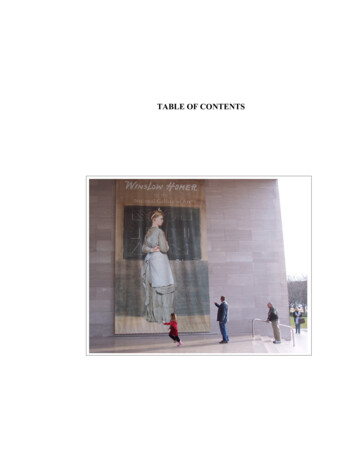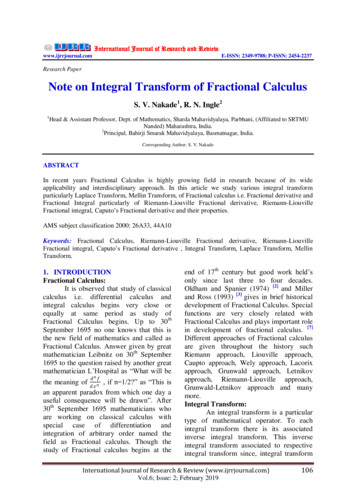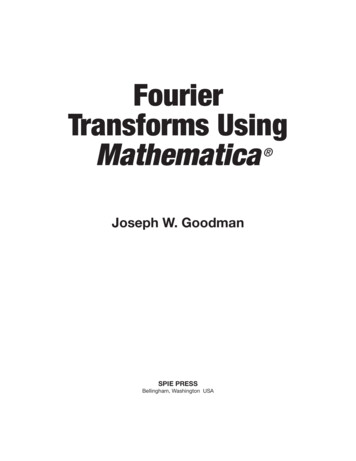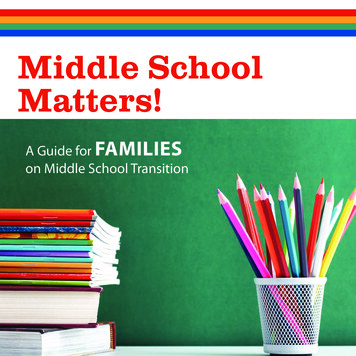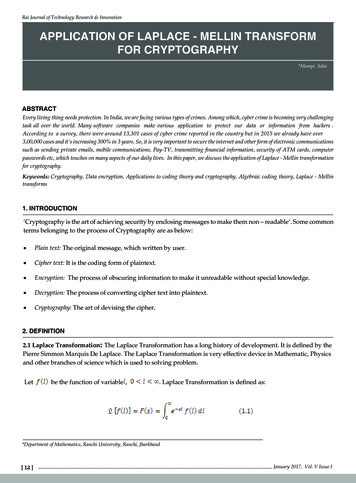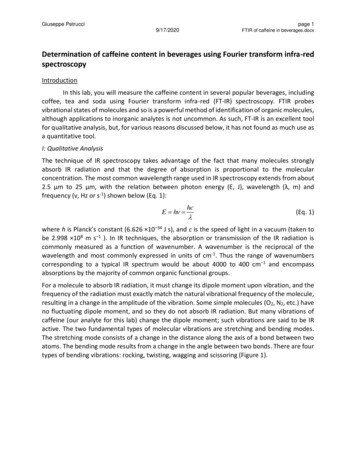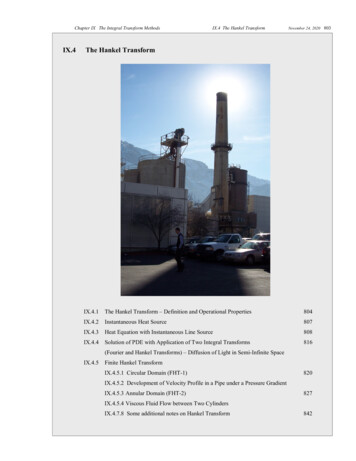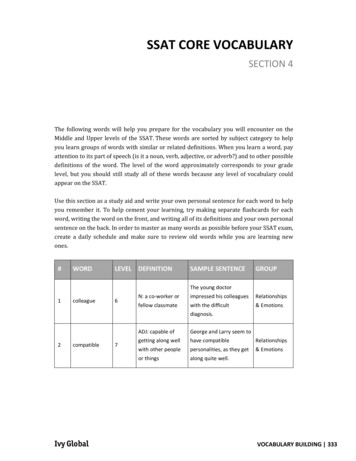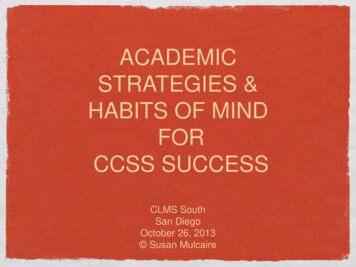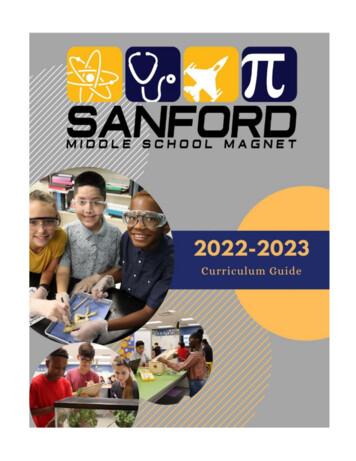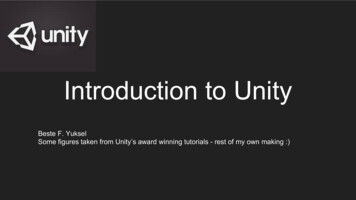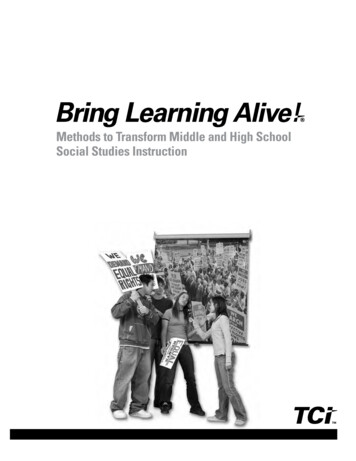
Transcription
Methods to Transform Middle and High SchoolSocial Studies Instruction
Special thanks to Dawn Lavond, teacher at S.C. Rogers Middle School,Moreland School District, San Jose, California, and to Cheryl Cook-Kallio,Social Studies Department Chair at Irvington High School, FremontUnified School District, Fremont, California, for the use of their classroomsfor photography.Chief Executive Officer: Bert BowerChief Operating Officer: Amy LarsonDirector of Product Development: Liz RussellManaging Editor: Laura AlavosusProject Editor: Ava HayesProduction Manager: Lynn SanchezDesign Manager: John F. KellyGraphic Designer: Victoria PhilpPhotographer: Tim StephensonContributing Writer: Sherry OwensIllustrator: DJ SimisonTeachers’ Curriculum InstituteP.O. Box 1327Rancho Cordova, CA 95741Customer Service: 800-497-6138www.teachtci.comCopyright 2010 by Teachers’ Curriculum Institute.No parts of this publication may be reproduced without written permissionfrom the publisher. Printed in the United States of America.ISBN 978-1-58371-113-22 3 4 5 6 7 8 9 10 -MLI- 15 14 13 12Manufactured by Malloy Lithographers, Ann Arbor, MIUnited States of America, April 2012, Job #SFI-00617
C o n t e n t sIntroduction2Part 19The Elements of the TCI ApproachTheory- and Research-Based Active Instruction10Standards-Based Content18Preview Assignment22Multiple Intelligence Teaching Strategies Visual Discovery28 Social Studies Skill Builder38 Experiential Exercise46 Writing for Understanding56 Response Group66 Problem Solving Groupwork76Considerate Text86Graphically Organized Reading Notes96Processing Assignment102Assessments to Inform Instruction118Part 2Creating a Cooperative, Tolerant Classroom135Part 3Using the Interactive Student Notebook161Part 4Making the TCI Approach Your Own173How to Adapt Lessons to Meet Your Students’ Needs174How to Hone Your Use of the Multiple IntelligenceTeaching Strategies182How to Develop Curriculum Using the TCI Approach220References248Credits249
IntroductionTeachers across the nation face the challenge of teaching a standards-based socialstudies curriculum. In some states, social studies has joined reading, writing,and math on the high-stakes standardized tests. Holding schools responsible formeasuring student mastery of social studies concepts has focused welcome attention on the place of social students in the overall school curriculum. However,many teachers feel unprepared to teach this subject. In an effort to be sure theyare covering all the material required by the standards, teachers may fall back ona straight textbook approach—read the chapter, answer the questions at the end—unfortunately resulting in many students who find social studies boring.Is the standards movement really at odds with engaging, dynamic instruction?At Teachers’ Curriculum Institute (TCI), we don’t believe this is an either-orproposition. Our years of classroom experience have shown that when socialstudies is taught through an active, student-centered approach, students do learnand remember important content. We have created a teaching approach thatis mindful of the challenges of standards-based instruction, yet also genuinelyexcites students about social studies. We call it the TCI Approach, and it is thebasis of the Bring Learning Alive! core program.2 Bring Learning Alive!“A child miseducated is achild lost.”—John F. Kennedy
How did this approach come about? It started in the 1980s when, as a small groupof middle and high school history teachers, we began experimenting with innovative instructional methods that generated unprecedented excitement among ourstudents. Weaving educational research and theory with the realities of classroomteaching, we developed the series of instructional practices that has come to beknown as the TCI Approach. Through TCI, founded in 1989, we have shared ourideas in workshops and summer institutes, helping teachers nationwide revitalizetheir social studies programs at the grassroots level. We have also published our owncurricular materials, both core and supplemental programs, in a line that continuesto expand each year.“This approach revolutionized my attitude aboutteaching because itshowed me how toincorporate the multipleintelligences into my dailyteaching repertoire.”—High School TeacherWe are continually refining and improving our teaching methodology to create abetter experience for the diverse students in our social studies classrooms. SocialStudies Alive! Engaging Diverse Learners in the Elementary Classroom (2003)introduced our methods to K–5 teachers. This book, Bring Learning Alive!Methods to Transform Middle and High School Instruction, is a parallel introduction to our methods for social studies teachers at grades 6–12. Our purpose isto convey a clear picture of the instructional practices that characterize the TCIApproach and to provide some practical tools for implementing those practices.As you study this approach, you will be reminded that outstanding teaching trulysupports standards-based instruction, and, even more important, excites studentsand fosters their love of learning.Teachers revitalize theirsocial studies programswith ideas they learn in TCIworkshops and summerinstitutes.Introduction 3
The TCI ApproachThe TCI Approach consists of a series of instructional practices that allows students of all abilities to experience key social studies concepts.Theory- and Research-Based Active InstructionLessons and activities are based on five well-established theories:1Multiple Intelligences—According to Howard Gardner’s revolutionarytheory, every student is intelligent—just not in the same way. Becauseeveryone learns in a different way, the best activities tap more than one kind ofintelligence. Gardner has described these seven intelligences: verbal-linguistic,logical-mathematical, visual-spatial, body-kinesthetic, musical-rhythmic,interpersonal, and intrapersonal.2Cooperative Interaction—Elizabeth Cohen’s research has led her toconclude that cooperative groupwork leads to learning gains and to higherstudent achievement. Cohen has found that if students are trained in cooperativebehaviors, placed in mixed-ability groups, and assigned roles to complete duringa multiple-ability task, they tend to interact more equally. This increased studentinteraction leads to more learning and greater content retention.Spiral Curriculum—Educational theorist Jerome Bruner championed theidea of the spiral curriculum, in which students learn progressively moredifficult concepts through a process of step-by-step discovery. With this approach,all students can learn once a teacher has shown them how to think and discoverknowledge for themselves.34Understanding by Design—Grant Wiggins and Jay McTighe believe thatteaching for deep understanding requires planning backward—first determining the big ideas students are to learn and then working backward to identifymethods to reach those goals and ways to assess the effectiveness of teaching.Nonlinguistic Representation—Many psychologists believe that we thinkand remember better when we store information in both linguistic andnonlinguistic forms. Research by Robert Marzano and colleagues demonstratesthat teaching with nonlinguistic activities such as graphic organizers, mentalimages, and movement helps to improve students’ understanding of content.5Standards-Based ContentDynamic lessons build mastery of state and national social studies standards.Integrates hands-on active learning, achieving a consistent pattern of high qualitysocial studies instruction while being mindful of standards.Preview AssignmentA short, engaging assignment at the start of each lesson helps you preview keyconcepts and tap students’ prior knowledge and personal experience.4 Bring Learning Alive!
Multiple Intelligences Teaching StrategiesMultiple Intelligence Teaching Strategies incorporate six types of activities:1Visual Discovery—Students view, touch, interpret, and bring to life2Social Studies Skill Builder—This strategy turns the traditional, rote3Experiential Exercise—These short, memorable activities make abstract4Writing for Understanding—These activities give all learners, even thosewith lesser linguistic skills, something memorable to write about.compelling images, turning what is usually a passive, teacher-centeredactivity —lecturing—into a dynamic, participative experience.tasks usually associated with skill-based worksheets into more dynamic,interactive activities.ideas or remote events accessible and meaningful by tapping intointrapersonal and body-kinesthetic intelligences.5Response Groups—This strategy helps students grapple with theambiguities of issues in social studies, recognize the complexity ofhistorical events, and discuss the consequences of public policies.Problem Solving Groupwork—This strategy teaches students the skillsnecessary to work together successfully in small groups, both in theclassroom and later in life.6Considerate TextCarefully structured reading materials enable students at all levels to understandwhat they read. Recognizes that a successful reading of expository text involvesfour stages: previewing the content, reading, taking notes, and processing thecontent or reviewing and applying what has been learned.Graphically Organized Reading NotesComprehensive graphic organizers used to record key ideas, further help studentsobtain meaning from what they read. Graphic organizers help students see theunderlying logic and interconnections among concepts by improving theircomprehension and retention in the subject area.Processing AssignmentAn end-of-lesson processing assignment, involving multiple intelligences andhigher-order thinking skills, challenges students to apply what they learned.Helps students synthesize and apply the information they have learned in avariety of creative ways.Assessments to Inform InstructionCarefully designed tests encourage students to use their various intelligences todemonstrate their understanding of key concepts while preparing them forstandardized tests.Introduction 5
Why Use the TCI Approach?Some of the teaching methods inherent in the TCI Approach will require thatyou make some or even many changes in the way you teach. Why should yourisk change? Here are some of the reasons given by teachers who use the TCIApproach.Teachers need innovative, practical alternatives to conventional social studiesteaching. Most teachers have discovered that conventional teaching reaches fewerand fewer students each year. They report that changes among their students—increased ethnic and linguistic diversity, shortened attention spans, lack ofparental involvement, time-consuming jobs, teen pregnancy, substance abuse, andnegative peer pressure—are making it increasingly difficult to teach. They need waysto reach their students that are dynamic yet practical. The TCI Approach providesan effective alternative to the traditional, teacher-centered classroom.Students are encouraged tobecome lifelong learners asteachers challenge them toapply their historical knowledge to the world aroundthem.6 Bring Learning Alive!Teachers need ways to help students see how the past is connected to thepresent. Students forget much of what they learn in social studies classesbecause they have no way to apply that knowledge. Teachers need to teach thatsocial studies concepts affect not only the past, but students’ lives today—ideas likethe use and abuse of power, discrimination, democratic involvement, immigration,and human settlement of the land. A study of the power of the federal governmentto alleviate poverty during the Roosevelt administration is brought up to date bya look at the government’s efforts to help the homeless today. The importance ofmusic in West African culture comes to life as students create their own music tocommunicate with other class members. An important goal is to help studentsbecome lifelong learners by constantly challenging them to apply their socialstudies knowledge to the world around them.
Teachers need guidance on how to create asupportive learning environment. Urging studentsto take risks, praising them for their attempts, andtreating mistakes and “failures” as learning opportunities can create a supportive learning environment.The result is more cooperative,tolerant behavior.To use their critical thinking skills, students needto become active learners. Students should learnsocial studies by involvement: leading, facilitating, acting, singing, discussing, drawing, makingdecisions, presenting, and critiquing. Active tasksrequire students to apply new knowledge as theysolve a problem, analyze a situation, understand aperspective, or evaluate alternatives. This type ofthinking involves higher-order intellectual skills.Students must be responsible for their own learning. Challenging students tocreate a product (a graphic organizer for their reading notes, a matrix, a poem, awritten dialogue, a visual metaphor, an illustrated spectrum) or a presentation(a PowerPoint display, a panel discussion, a dramatization, an oral report) allowsthem to take ownership of the learning process. This results in a high level ofinvolvement and follow-through on class activities.Students need more time to work together. Rather than just having studentswork individually or sit collectively during a lecture, using strategies that dependon student interaction with peers teaches vital social skills and leads to learninggains.“I love this approach. Itnot only has helped tomotivate my students’learning, but also has mademe more reflective as ateacher.”—Middle School TeacherTeachers who are sensitive to issues of multiculturalism need realistic ways toteach social studies from a variety of perspectives. Teaching from a multicultural perspective, and stressing that the differences among races, nations, andethnic cultures are at least as profound and as durable as the similarities, helpsstudents learn to appreciate and navigate those differences in their increasinglyglobalized world.Teachers need to nurture their zest for teaching. Most teachers enter theprofession with a sense of purpose: to reach the unreachable student, to create abetter future by educating the leaders of tomorrow, to prepare students for participation in a democratic society. The stressful reality of school life, however, dimsmany a teacher’s initial optimism. Teachers using the TCI Approach often reporta renewed sense of idealism as they rediscover the mission and the enjoymentthey first associated with teaching. They find they are reaching all their students,not just the “best,” and they report that this is the way they always wanted toteach—with a sense of purpose, passion, and fun.Introduction 7
What You Can Expect from This BookThis book is an instructional methods text that will give you a thorough understanding of how to implement the TCI Approach in your middle or high schoolsocial studies classroom. Part 1 further explores the eight features of the approachand describes the steps for using each of the six multiple intelligence teachingstrategies. Part 2 explains the process for creating a cooperative, tolerant environment in your classroom—a key to your success with all other parts of the TCIApproach. Part 3 gives you tips on using the Interactive Student Notebook as anengaging way for students to organize information and ponder historical questions.Part 4 helps you hone your skills in using the TCI Approach, whether you havepurchased TCI curricular materials or are designing your own units. Part 5 may bethe most practical section of the book, with sample lessons that you can actually tryin your classroom or that you can use as models for developing rich interactive andcollaborative lessons of your own. The lessons in this section include examples of allsix multiple intelligence teaching strategies.“You remember better.Usually, you just space outwhen you’re done readingand you don’t rememberanything you read. Theactivities in this programgive us an interactive feelingabout social studies and wehave fun learning.”—Middle School Student8 Bring Learning Alive!Each part of the book takes into account the needs and perspectives of two groupsof potential users: (1) those of you who are completely new to the TCI Approachand would like to learn more, either about using TCI’s published programs or aboutadapting the general approach to design powerful, multiple-intelligencelessons that support any curriculum, and (2) those of you who are already usingTCI’s programs and want to strengthen your lesson presentations with creativeideas that get immediate classroom results. For both groups, the book is chock-fullof practical instructional tips and strategies, supported by examples from publishedTCI activities. Whether you teach history, geography, civics, economics, or somecombination of these, the TCI Approach will help you offer more active, meaningfulinstruction in an energized, revitalized classroom.
P A R TThe Elements of theTCI Approach19
Theory- and Research-Based ActiveInstructionYes! They are highly diverse,but according to the theoryof multiple intelligences,every student is intelligent—just not in the same way.The TCI Approach was developed by teachers who sought to combine what theyhad learned from classroom experience with the accepted wisdom of educa tional theory and research. From years of working with students, these teachersobserved that when kids are active, they stay focused, are more motivated, andlearn better. Thus, “active learning” was an essential ingredient of their emergingapproach. To this foundation, they added ideas drawn from Howard Gardner’stheory of multiple intelligences, Elizabeth Cohen’s research on cooperative group work, Jerome Bruner’s spiral curriculum, Grant Wiggins’ and Jay McTighe’sunderstanding by design, and Robert Marzano’s nonlinguistic representation.Educational theory, then, contributed the five key premises behind the TCIApproach: (1) students learn best through multiple intelligences, (2) cooperativeinteraction increases learning (3) all students can learn via the spiral curriculum,(4) students benefit from having explicit learning goals, and (5) learning is opti mized when linguistic and nonlinguistic experiences are valued equally.The Theory of Multiple IntelligencesThe typical classroom contains a broad range of abilities. In an eighth-gradeU.S. history class, Stacy reads at the eleventh-grade level, while Stephen struggleswith a fifth-grade book; Tricia turns out essays acceptable to a high school10 Bring Learning Alive!
teacher, while Shirley still writes at a sixth-grade level; Juan is a skilled orator,while Dominga hardly says a word. Many middle and high school educators haveconfronted this challenge by placing students in leveled ability groups—as earlyas seventh grade. However, this type of academic tracking poses a fundamentaldilemma. A crucial goal of social studies education is to prepare students foreffective participation in a pluralistic society, yet policies that separate studentsfrom one another according to academic ability also tend to separate them bysocial class, race, and language.“With the three premisesbuilt into all the lessonsand activities, what wasonce a dusty, dry area oflearning for most teachersand students is now fresh,exciting, and engaging.”— Middle School TeacherAcademic segregation sends students a clear message: equal participation andcooperation by diverse groups in society is possible in theory only. Psychologistsand learning theorists, however, have proposed an alternative concept of intelli gence that abandons the outdated practice of academic tracking.Howard Gardner, a neuropsychologist at Harvard University, argues that we mustdevelop a new way of looking at human intelligence:“In my view, if we are to encompass adequately the realm of human cogni tion, it is necessary to include a far wider and more universal set of competen cies than has ordinarily been considered. And it is necessary to remain opento the possibility that many—if not most—of these competencies do not lendthemselves to measurement by standard verbal methods, which rely heavilyon a blend of logical and linguistic abilities. With such considerations inmind, I have formulated a definition of what I call an ‘intelligence.’ An intel ligence is the ability to solve problems, or to create products, that are valuedwithin one or more cultural settings.” (Gardner 1993, p. x)Actively involved studentsare motivated students.Here, they step into history as they study ManifestDestiny though a painting.Theory- and Research-Based Active Instruction 11
Students use an arrayof intelligences to createa human monumentcommemorating life inthe Byzantine Empire afterthe fall of Rome.“I don’t like to just sit inmy seat all day. I dobetter when my teacherlets us move around andact things out. Those arethe things I remember.”Gardner relies on neurological research to argue that the human mind has at leastseven relatively autonomous human intellectual competencies, each with its owndistinctive mode of thinking, to approach problems and create products. (Gardnerhas more recently identified an eighth intelligence, and is investigating at least oneother.) The TCI Approach taps into the following seven intelligences as describedby Gardner:— Middle School Student Linguistic intelligence is responsible for the production of language and allthe complex possibilities that follow, including poetry, humor, storytelling,grammar, metaphors, similes, abstract reasoning, symbolic thinking, impromptuspeaking, oral debate, conceptual patterning, and all genres of the written word.Linguistic intelligence is awakened by the spoken word; by reading someone’sideas or poetry; by writing one’s own ideas, thoughts, or poetry; and by listen ing to a speech, lecture, or group discussion. Logical-mathematical intelligence is most often associated with what iscalled scientific thinking or deductive reasoning: the ability to observe andunderstand details as part of a general pattern. Inductive thought processes are12 Bring Learning Alive!
also involved, such as the ability to make objective observations, and, fromthe observed data, to draw conclusions, to make judgments, and to formulatehypotheses. Logical-mathematical intelligence involves the capacity to recog nize patterns, to work with abstract symbols, and to discern relationships andsee connections. Visual-spatial intelligence deals with such things as the visual arts (includingpainting, drawing, and sculpting), navigation, mapmaking, and architecture,all of which involve physical awareness and the use of space. Games such aschess and marbles, which require the ability to visualize objects from differentperspectives and angles, are also included. The key sensory base of this intel ligence is the sense of sight, but the ability to form images and pictures in themind is also involved.Let Your Students “Feel”ConceptsFew techniques are morepowerful for connectingstudents with importantconcepts than creatingopportunities for them tostep into the shoes ofrelevant figures and reactto the issues, passions,and events affecting them. Body-kinesthetic intelligence is the ability to use the body to express emo tion (as in dance and body language), to play a game (as in sports), or to createa new product (an invention). Learning by doing has long been recognized asan important part of education. Our bodies know things our minds don’t andcan’t know in any other way. Actors, clowns, and mimes demonstrate theendless possibilities for using the body to know, understand, and communicatein ways that touch the human spirit.Musical and intrapersonalintelligences come into playas these students learnabout four forms of government—monarchy, oligarchy,tyranny, and democracy—by trying different waysof choosing music to playfor the class. Here, a monarch makes the decision.Students note their feelings,and later link this experienceto the rise of democracy inancient Greece.Theory- and Research-Based Active Instruction 13
Musical-rhythmic intelligence includes the recognition and use of rhythmicCognitive Pluralism:More than BuzzwordsEvery social studies objective should be taughtthrough as many of theintelligences as possible.This allows for more equitable learning by giving allstudents access to ideas.and tonal patterns, as well as sensitivity to sounds in the environment, thehuman voice, and musical instruments. Of all forms of intelligence identifiedthus far, musical-rhythmic intelligence has the greatest “consciousness alter ing” effect on the brain. Music calms you when you are stressed, stimulates youwhen you are bored, and helps you attain a steady rhythm during such acts astyping and exercising. It has been used to inspire religious beliefs, to intensifynational loyalties, and to express great loss or profound joy. Interpersonal intelligence involves the ability to work cooperatively in agroup and the ability to communicate, verbally and nonverbally. It builds onthe capacity to notice contrasts in moods, temperament, motivations, andintentions among other people. Those with highly developed interpersonalintelligence can have genuine empathy for another’s feelings, fears, anticipa tions, and beliefs. Counselors, teachers, therapists, politicians, salespeople, andreligious leaders usually have strong interpersonal intelligence. Intrapersonal intelligence involves knowledge of internal aspects of the selfCooperative groupworkpromotes student achievement and productivity. Themore students interact witheach other, the more theywill learn and remember.14 Bring Learning Alive!such as feelings, the range of emotional responses, thinking processes, selfreflection, and a sense of (or intuition about) spiritual realities. Intrapersonalintelligence allows you to be conscious of your consciousness. Self-image andthe ability to transcend the self are part of the functioning of intrapersonalintelligence.
Cooperative InteractionThe second theoretical premise behind the TCI Approach is easily stated:Cooperative interaction leads to learning gains. Researchers report that coopera tive groupwork promotes higher student achievement and productivity than eithercompetitive or individualist teaching methods; the more opportunities studentshave to interact—by discussing a controversial topic, preparing one another for aquiz, conducting peer interviews—the more they will learn and remember.However, sociologists have discovered when students perform a collective task,some are more influential than others. Elizabeth Cohen (1986) has found thatstudents expect certain performances from one another. Students prejudge whattheir peers will be able to contribute on the basis of perceived academic abilityand peer status. As a group, they believe some students are “low status” andothers are “high status.” When high-status and low-status students work together,a self-fulfilling prophecy results: perceived high-status students tend to interpretmost of the questions, talk more, and have their opinions accepted more oftenthan do students perceived as low-status. This inequality results in a learningdisparity: high-status students, because they interact more, learn more; low-statusstudents, because their interaction is severely limited, learn less.“Groupwork is aneffective technique forachieving certain kindsof intellectual and sociallearning goals. It is asuperior technique forconceptual learning, forcreative problem solving,and for increasing orallanguage proficiency.”— Elizabeth Cohen,Professor of Education,Stanford UniversityVirtually every teacher faces the problem of status inequality. Researchers haveshown that such inequality exists in every classroom, no matter how homoge neous a classroom may appear (Berger, Rosenholtz, and Zelditch 1980). Unless weacknowledge this problem and deal with it frankly, our efforts to increase studentinteraction may ultimately backfire if high-status students reap all the benefits.Fortunately, research has uncovered practical ways to combat the problem. Cohenhas found that when teachers use heterogeneous groups and learn how to changeexpectations for competence, the low-status students participate more andhigh-status students no longer dominate. Cohen’s work has focused exclusivelyon students working in groups of four or five; the classroom implications of herstudies are explored in greater detail in the later discussion of the strategy“Problem Solving Groupwork” (p. 76).Many of the techniques that Cohen has found effective with small groups canbe used with larger groups and paired instruction as well. By implementing theseideas in combination with Howard Gardner’s theory of multiple intelligences,you can create cooperative interaction. All students in the heterogeneous class room become convinced that they possess skills that are valued. With the TCIApproach, your activities combat the problem of status inequality by tapping intothe multiple intelligences, enabling you to create cooperative interaction that leadsto learning gains for all students.“Theory. Theory. Theory.Teachers always heartheories. But the beautyof this approach is thatfinally, theory is put intopractice. This changeswhat happens in theclassroom.”— High School TeacherTheory- and Research-Based Active Instruction 15
The Spiral Curriculum in ActionBenjamin Bloom’sTaxonomy: A Guidefor Creating QuestionsKnowledge The abilityto recall specifics, universals, methods, processes,and patternsComprehension Theability to translate, interpret, and extrapolateApplication The abilityto use abstractions inconcrete situationsAnalysis The ability toanalyze elements, relationships, and organization principlesSynthesis The ability toput together elementsand parts to form awholeEvaluation The ability tomake judgments aboutthe value of ideas, works,solutions, and methodsBy carefully spiraling yourquestions f
studies curriculum. In some states, social studies has joined reading, writing, and math on the high-stakes standardized tests. Holding schools responsible for measuring student mastery of social studies concepts has focused welcome atten-tion on the place of social students in the o
